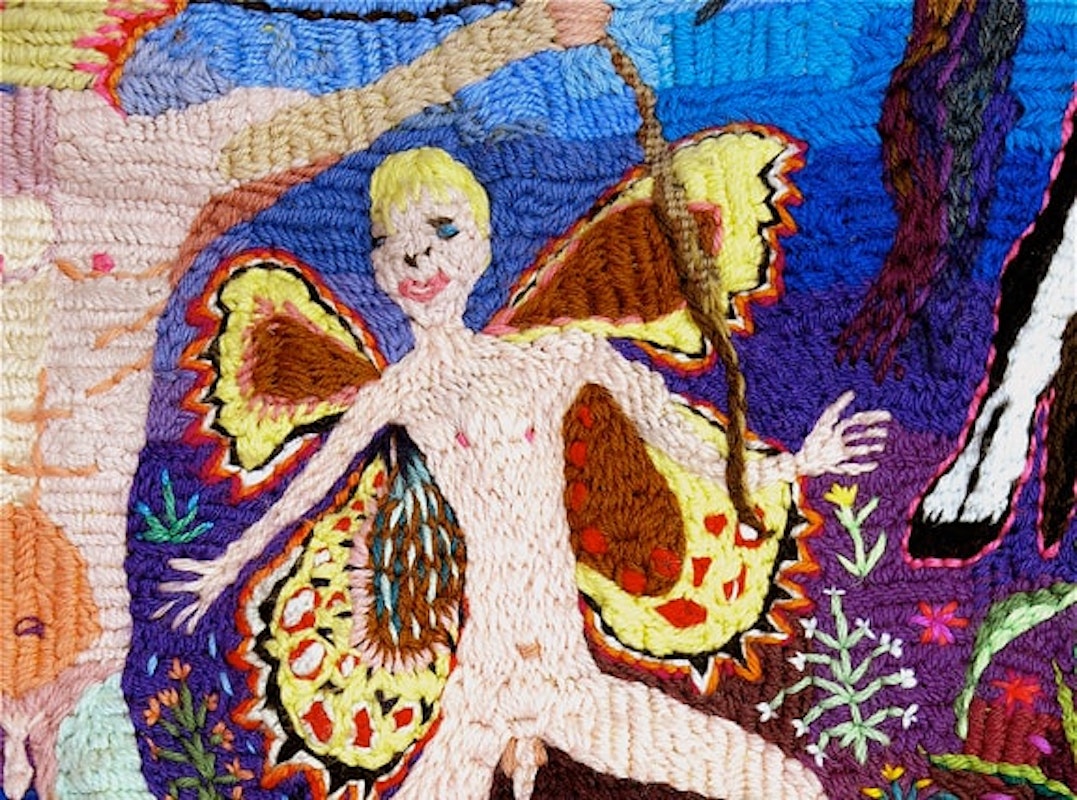
17 November -
15 December 2012
200 Gertrude Street
200 Gertrude Street, FitzroyIn this exhibition Paul Yore presents new tapesty and sculptural works.
Catalog text produced for Gertrude Contemporary and Art and Australia Emerging Writers Program -
Paul Yore’s Studio 12 exhibition BOYS GONE WILD is named after the central work in the show - a needlepoint wall-hanging – that takes its title from William S. Burroughs’ 1971 novel The Wild Boys, A Book of the Dead. Alongside two text-based needlepoint works and a small ebony sculpture, Boys Gone Wild provides a view into a fantastic penny arcade.
Boys Gone Wild is built with numerous sections of needlepoint mesh that Yore has stitched together. Analogous with his shrine-like sculptures, Yore’s stitched works are collages of collected images that have been translated with embroidery wool onto a single plane. Yore has collected sections of the needlepoint mesh in op shops and craft stores, some pre-printed with floral designs for the hobbyist to complete, others bought blank and cut to fit. Yore absorbs the imagery of the pre-printed mesh, following parts of the design and twisting it to include imagery from other decorative arts - Flemish tapestries, Persian miniatures, mid-Twentieth Century Australiana - and combines them with pop-cultural sources.
It is relevant here to distinguish between needlepoint (which is worked over a wide-spaced mesh), and other forms of embroideries (which are embellishments of already-woven fabric). When stitching a design in needlepoint, the stitches form a surface that constitutes the fabric itself. As each stitch is woven in and out through the stiffened net, the net contracts, and the stitches form a close-fitting graphic image. The process of the object’s making is apparent in Yore’s final product, and includes the mis-steps and compromises encountered in his partial improvisation of the design. Different sections have been collated as the piece has progressed, allowing Yore to make formal decisions throughout the making of the work. The process is slow, meditative, and conducive to thinking - a pace at odds with the way many of the source photographs are made. Yore’s design is compiled primarily from images found on the internet, which are then augmented by imagination, invention, and the necessary compromise of the technique.
Figures in the near and far distance are made up of the same-sized chunky stitching, which creates a dense textural object but flattens the internal space of the composition. Passages of Boys Gone Wild recall densely-worked Medieval tapestries, in which small animals and flora crowd the ‘ground’ between major figures in the composition, adding elaborate pattern and coded symbols to the intricacy of the image, and lending consistency to the overall design. Yore revisits these conventions, filling space with more personally relevant symbols: phallic mushrooms, cannabis plants, a magpie, and a rosella. Naked, youthful male figures are rendered frozen in moments of joy or erotic play. Animated actions are made static by the slow, repetitive task of embrodery, the reproduction taking much longer to produce than the original act.
The flora and fauna situate Yore’s vision outside, in nature, invoking a naturalist utopia where man (but seemingly not woman) is youthful in his freedom. Recalling the now retro-futurist feel of The Wild Boys, Yore’s figures suggest a very different time in the not-so-distant future, aesthetically informed by 1960s psychedelia, Mexican pop-religious iconography and more recent queer culture. Like Burroughs’ text Yore’s composition eschews linear narrative, adapting Burroughs’ ‘cut-up’ technique to allow chance and process to influence the final form of his works.
Yore is interested in the shared etymology of ‘text’ and ‘textile’: both of which come from ‘tek-’, make, and entail a process of weaving discrete elements, according to a particular system, into a communicative whole. Particular characters from Burroughs’ text appear in cameo roles in Yore’s textile, including an armed Wild Boy and a tree-dwelling Wild Boy. Yore’s sculpture natural object, too, is a quotation of Burroughs’ “phallic statue of ebony with … a tiny opal set in the tip”. Beyond Burroughs, Boys Gone Wild is a contemporary re-framing of Hieronymous Bosch’s Garden of Earthly Delights, in which the depictions of Innocence and of Hell are forgone, replaced by an even wider panorama of life to be interpreted as either the fall of man, or paradise lost, depending on the projections of the viewer.
Boys Gone Wild proposes a peep-show approach to storytelling, where a brief glimpse is offered into each particular episode, and the viewer moves from scene to scene as paying voyeur. The story, if indeed Yore allows one in his work, is denied any foreword by its author. The characters can tell no history – nor wish to – and there is no foreshadowing of a future. Yore constructs an endlessly absorbing deferral of truth and consequence, portraying instead a mystic and scrambled chronology of infinite instant gratification.
